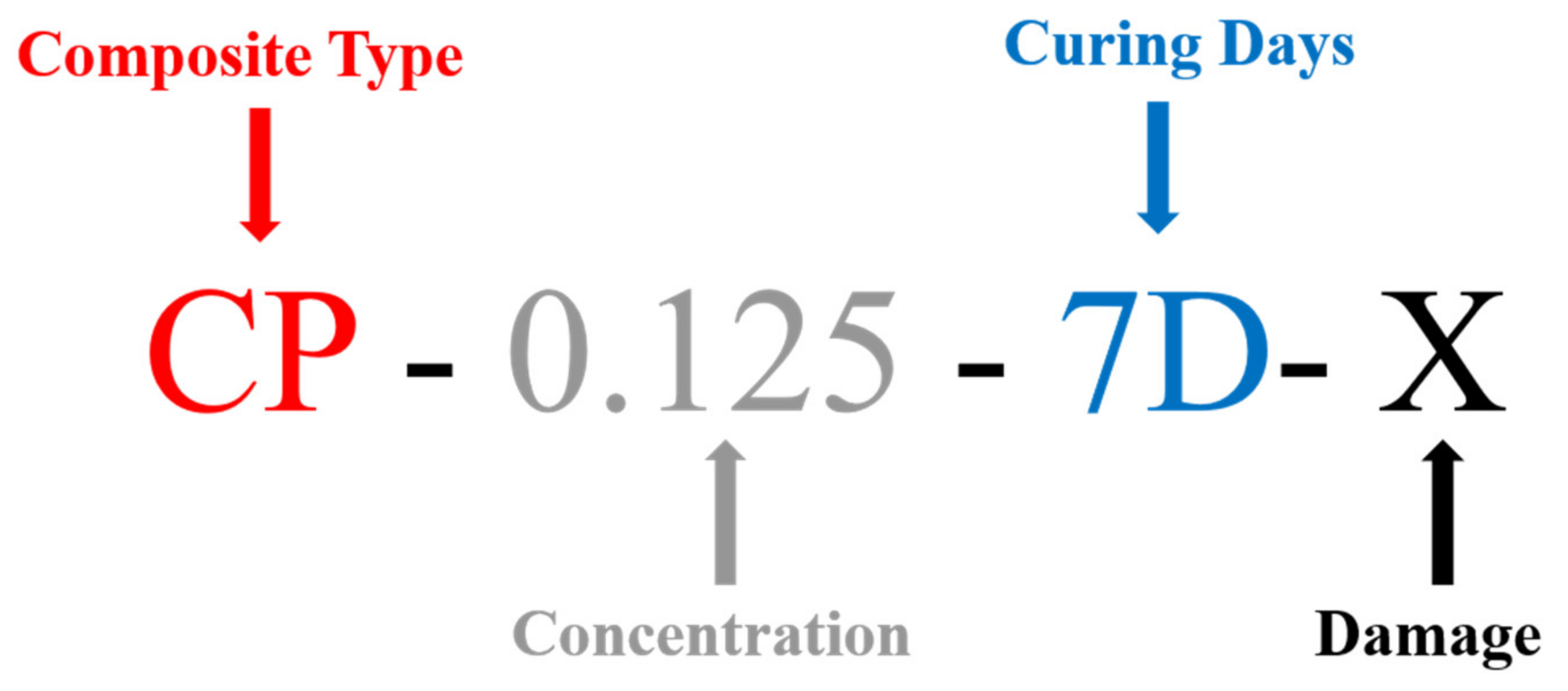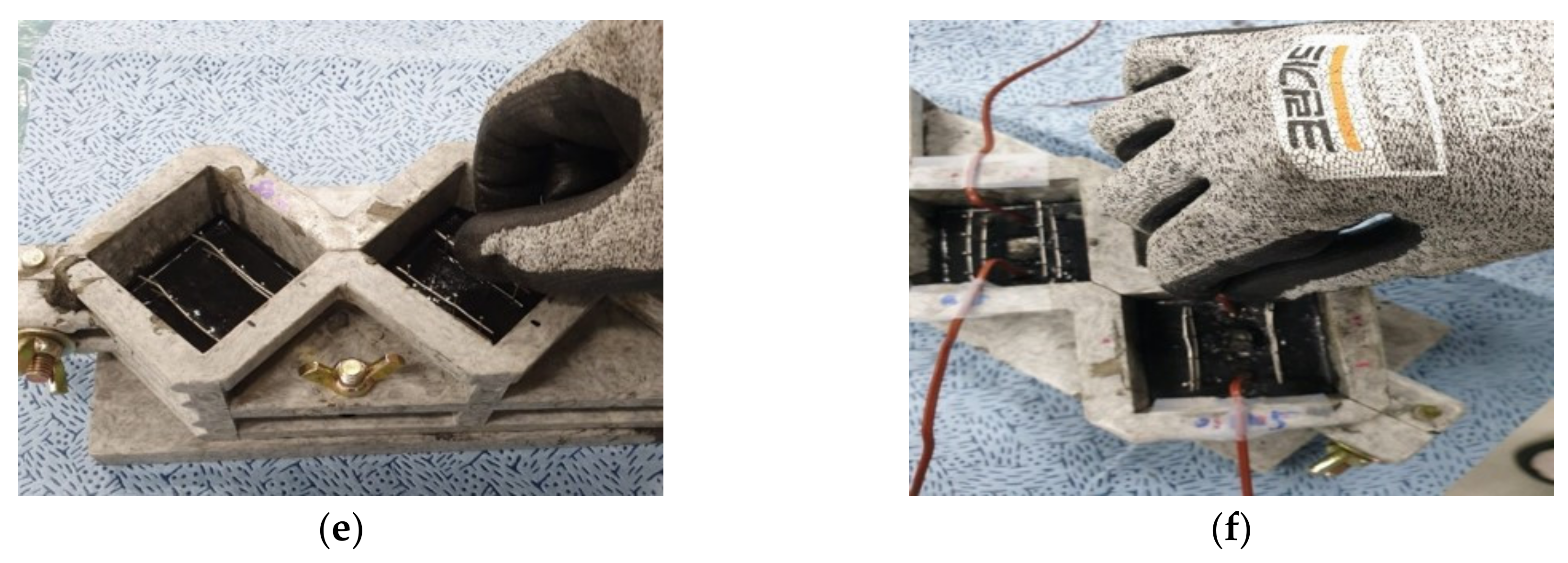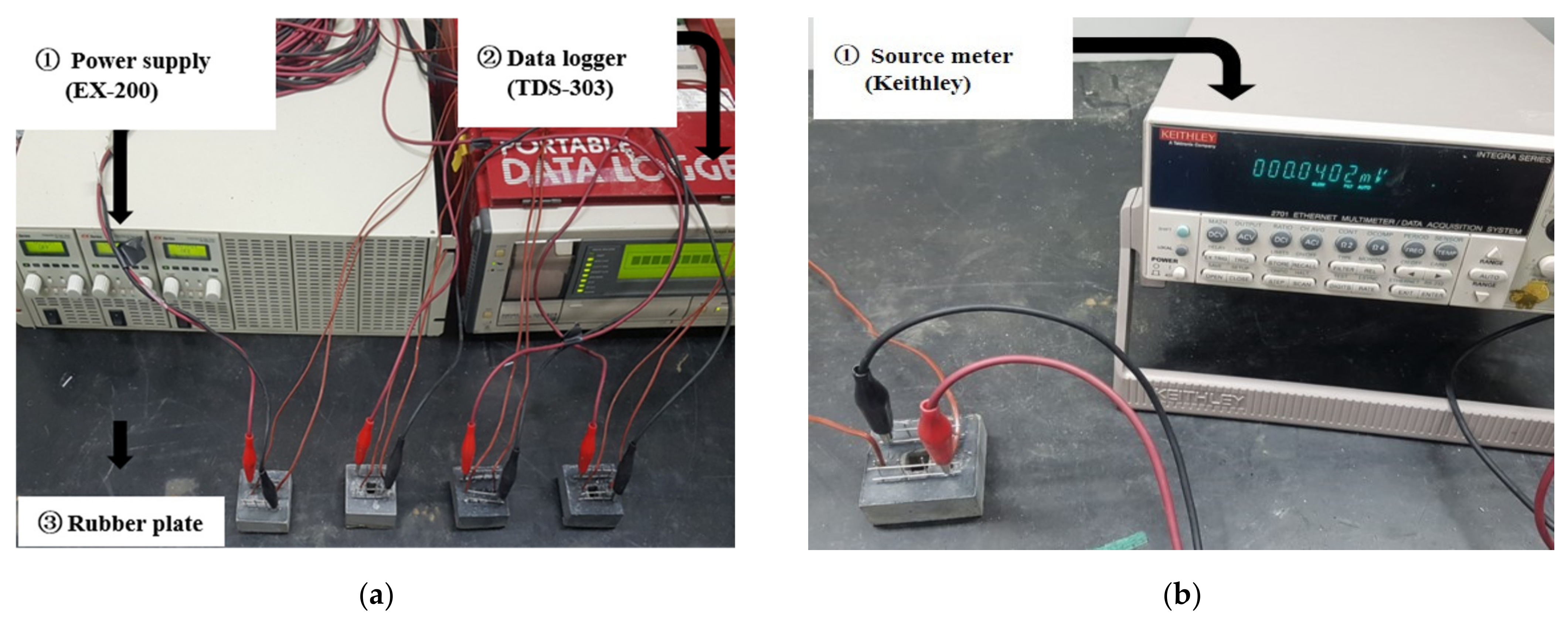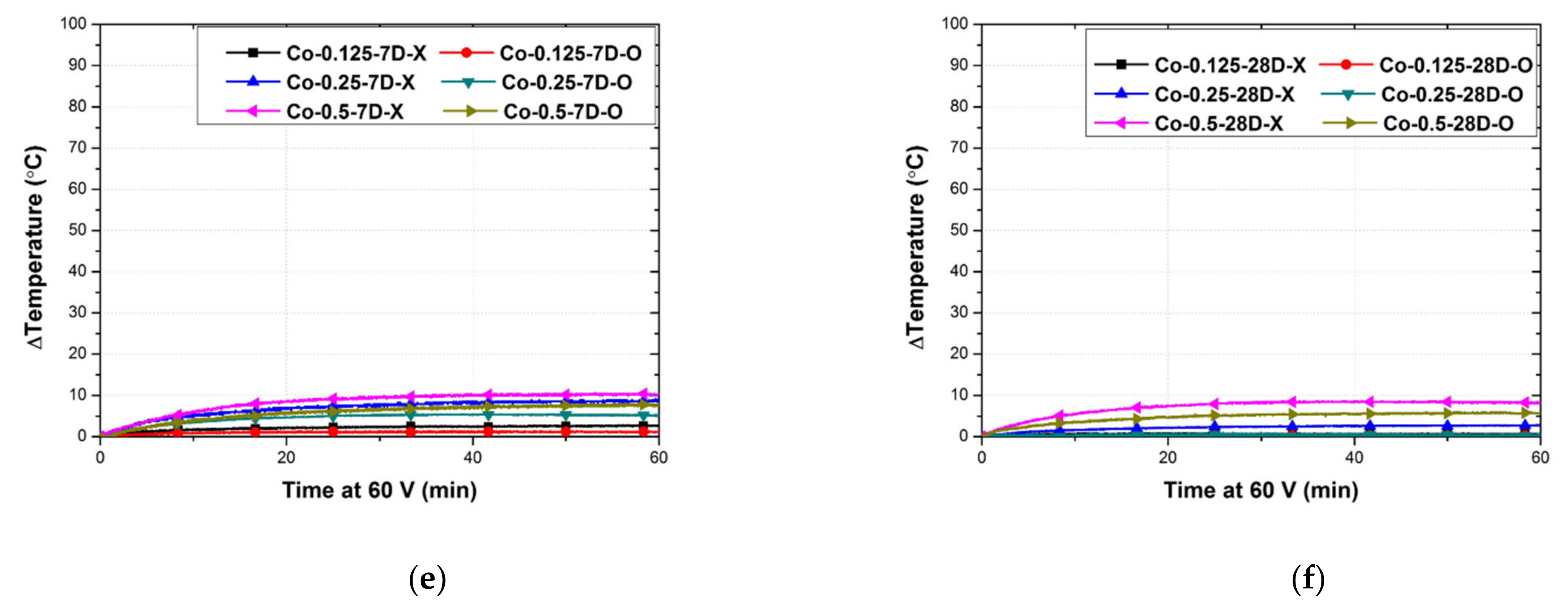Damage Detection of Carbon Nanotube Cementitious Composites Using Thermal and Electrical Resistance Properties
Abstract
1. Introduction
2. Experimental Program
3. Experimental Results
3.1. Heat Test and Thermal Imaging Analysis Results
3.2. Electrical Resistance Testing
3.3. Microstructure and Discussion
4. Conclusions
Author Contributions
Funding
Conflicts of Interest
References
- Presting, H.; König, U. Future nanotechnology developments for automotive applications. Mater. Sci. Eng. C 2003, 23, 737–741. [Google Scholar] [CrossRef]
- Wang, G.-F.; Tao, X.-M.; Wang, R.-X. Flexible organic light-emitting diodes with a polymeric nanocomposite anode. Nanotechnology 2008, 19, 145201. [Google Scholar] [CrossRef] [PubMed]
- Sanchez, F.; Sobolev, K. Nanotechnology in concrete–A review. Constr. Build. Mater. 2010, 24, 2060–2071. [Google Scholar] [CrossRef]
- Raki, L.; Beaudoin, J.; Alizadeh, R.; Makar, J.M.; Sato, T. Cement and Concrete Nanoscience and Nanotechnology. Materials 2010, 3, 918–942. [Google Scholar] [CrossRef]
- Pacheco-Torgal, F.; Jalali, S. Nanotechnology: Advantages and drawbacks in the field of construction and building materials. Constr. Build. Mater. 2011, 25, 582–590. [Google Scholar] [CrossRef]
- Nima, F.; Ali, A.A.A.; Demirboğa, R. Development of Nanotechnology in High Performance Concrete. Adv. Mater. Res. 2011, 364, 115–118. [Google Scholar] [CrossRef]
- Norhasri, M.M.; Hamidah, M.; Fadzil, A.M. Applications of using nano material in concrete: A review. Constr. Build. Mater. 2017, 133, 91–97. [Google Scholar] [CrossRef]
- Yu, X.; Kwon, E. A carbon nanotube/cement composite with piezoresistive properties. Smart Mater. Struct. 2009, 18, 055010. [Google Scholar] [CrossRef]
- Azhari, F.; Banthia, N. Cement-based sensors with carbon fibers and carbon nanotubes for piezoresistive sensing. Cem. Concr. Compos. 2012, 34, 866–873. [Google Scholar] [CrossRef]
- Wang, B.; Guo, Z.; Han, Y.; Zhang, T. Electromagnetic wave absorbing properties of multi-walled carbon nanotube/cement composites. Constr. Build. Mater. 2013, 46, 98–103. [Google Scholar] [CrossRef]
- Cerro-Prada, E.; Pacheco-Torres, R.; Varela, F. Effect of Multi-Walled Carbon Nanotubes on Strength and Electrical Properties of Cement Mortar. Materials 2020, 14, 79. [Google Scholar] [CrossRef] [PubMed]
- Siddique, R.; Mehta, A. Effect of carbon nanotubes on properties of cement mortars. Constr. Build. Mater. 2014, 50, 116–129. [Google Scholar] [CrossRef]
- Lee, H.; Jeong, S.; Park, S.; Chung, W. Enhanced mechanical and heating performance of multi-walled carbon nanotube-cement composites fabricated using different mixing methods. Compos. Struct. 2019, 225, 111072. [Google Scholar] [CrossRef]
- Lee, H.; Jeong, S.; Cho, S.; Chung, W. Enhanced bonding behavior of multi-walled carbon nanotube cement composites and reinforcing bars. Compos. Struct. 2020, 243, 112201. [Google Scholar] [CrossRef]
- Nan, C.-W.; Liu, G.; Lin, Y.; Li, M. Interface effect on thermal conductivity of carbon nanotube composites. Appl. Phys. Lett. 2004, 85, 3549–3551. [Google Scholar] [CrossRef]
- Li, G.Y.; Wang, P.M.; Zhao, X. Pressure-sensitive properties and microstructure of carbon nanotube reinforced cement com-posites. Cem. Concr. Compos. 2007, 29, 377–382. [Google Scholar] [CrossRef]
- Zhang, Q.; Li, H. Experimental investigation on the ice/snow melting performance of CNFP & MWCNT/cement-based deicing system. In Proceedings of the 6th International Workshop on Advanced Smart Materials and Smart Structures Technology, Dalian, China, 25–26 July 2011. [Google Scholar]
- Saafi, M.; Andrew, K.; Tang, P.L.; McGhon, D.; Taylor, S.; Rahman, M.; Yang, S.; Zhou, X. Multifunctional properties of carbon nanotube/fly ash geopolymeric nanocomposites. Constr. Build. Mater. 2013, 49, 46–55. [Google Scholar] [CrossRef]
- Kim, H.; Nam, I.; Lee, H. Enhanced effect of carbon nanotube on mechanical and electrical properties of cement composites by incorporation of silica fume. Compos. Struct. 2014, 107, 60–69. [Google Scholar] [CrossRef]
- Kim, G.M.; Naeem, F.; Kim, H.K.; Lee, H.K. Heating and heat-dependent mechanical characteristics of CNT-embedded ce-mentitious composites. Compos. Struct. 2016, 136, 162–170. [Google Scholar] [CrossRef]
- García-Macías, E.; d’Alessandro, A.; Castro-Triguero, R.; Pérez-Mira, D.; Ubertini, F. Micromechanics modeling of the electrical conductivity of carbon nanotube cement-matrix composites. Compos. Part B Eng. 2017, 108, 451–469. [Google Scholar] [CrossRef]
- Lee, H.; Song, Y.M.; Loh, K.J.; Chung, W. Thermal response characterization and comparison of carbon nanotube-enhanced cementitious composites. Compos. Struct. 2018, 202, 1042–1050. [Google Scholar] [CrossRef]
- Lee, H.; Kang, D.; Kim, J.; Choi, K.; Chung, W. Void detection of cementitious grout composite using single-walled and multi-walled carbon nanotubes. Cem. Concr. Compos. 2019, 95, 237–246. [Google Scholar] [CrossRef]
- Hanxun, B.; Yu, X.; Ou, J. Effect of water content on the piezoresistivity of MWNT/cement composites. J. Mater. Sci. 2010, 45, 3714–3719. [Google Scholar] [CrossRef]
- Galao, O.; Baeza, F.; Zornoza, E.; Garcés, P. Strain and damage sensing properties on multifunctional cement composites with CNF admixture. Cem. Concr. Compos. 2014, 46, 90–98. [Google Scholar] [CrossRef]
- Konsta-Gdoutos, M.S.; Aza, C.A. Self sensing carbon nanotube (CNT) and nanofiber (CNF) cementitious composites for real time damage assessment in smart structures. Cem. Concr. Compos. 2014, 53, 162–169. [Google Scholar] [CrossRef]
- Dalla, P.T.; Dassios, K.G.; Tragazikis, I.K.; Exarchos, D.A.; Matikas, T.E. Carbon nanotubes and nanofibers as strain and damage sensors for smart cement. Mater. Today Commun. 2016, 8, 196–204. [Google Scholar] [CrossRef]
- Korean Standards Association. KSL ISO 679, Methods of Testing Cements-Determination of Strength; Korean Standards Association: Seoul, Korea, 2011. [Google Scholar]
- Korean Standards Association. KSL 5201, Portland Cement; Korean Standards Association: Seoul, Korea, 2016. [Google Scholar]
- Sobolkina, A.; Mechtcherine, V.; Khavrus, V.; Maier, D.; Mende, M.; Ritschel, M.; Leonhardt, A. Dispersion of carbon nanotubes and its influence on the mechanical properties of the cement matrix. Cem. Concr. Compos. 2012, 34, 1104–1113. [Google Scholar] [CrossRef]
- Lee, H.; Park, S.; Park, S.; Chung, W. Enhanced detection systems of filling rates using carbon nanotube cement grout. Nanomaterials 2020, 10, 10. [Google Scholar] [CrossRef]
- Al-Dahawi, A.; Öztürk, O.; Emami, F.; Yıldırım, G.; Şahmaran, M. Effect of mixing methods on the electrical properties of cementitious composites incorporating different carbon-based materials. Constr. Build. Mater. 2016, 104, 160–168. [Google Scholar] [CrossRef]
- Lee, H.; Park, S.; Cho, S.; Chung, W. Correlation analysis of heating performance and electrical energy of multi-walled carbon nanotubes cementitious composites at sub-zero temperatures. Compos. Struct. 2020, 238, 111977. [Google Scholar] [CrossRef]
- Lee, H.; Yu, W.; Loh, K.J.; Chung, W. Self-heating and electrical performance of carbon nanotube-enhanced cement composites. Constr. Build. Mater. 2020, 250, 118838. [Google Scholar] [CrossRef]















| Specimen Name | Composite Type | Curing Days | Concentration (wt%) |
|---|---|---|---|
| CP-0.125-7D-X | Cement paste | 7 | 0.125 |
| CP-0.125-7D-O | |||
| CP-0.25-7D-X | 0.25 | ||
| CP-0.25-7D-O | |||
| CP-0.5-7D-X | 0.5 | ||
| CP-0.5-7D-O | |||
| CP-0.125-28D-X | 28 | 0.125 | |
| CP-0.125-28D-O | |||
| CP-0.25-28D-X | 0.25 | ||
| CP-0.25-28D-O | |||
| CP-0.5-28D-X | 0.5 | ||
| CP-0.5-28D-O | |||
| M-0.125-7D-X | Mortar | 7 | 0.125 |
| M-0.125-7D-O | |||
| M-0.25-7D-X | 0.25 | ||
| M-0.25-7D-O | |||
| M-0.5-7D-X | 0.5 | ||
| M-0.5-7D-O | |||
| M-0.125-28D-X | 28 | 0.125 | |
| M-0.125-28D-O | |||
| M-0.25-28D-X | 0.25 | ||
| M-0.25-28D-O | |||
| M-0.5-28D-X | 0.5 | ||
| M-0.5-28D-O | |||
| Co-0.125-7D-X | Concrete | 7 | 0.125 |
| Co-0.125-7D-O | |||
| Co-0.25-7D-X | 0.25 | ||
| Co-0.25-7D-O | |||
| Co-0.5-7D-X | 0.5 | ||
| Co-0.5-7D-O | |||
| Co-0.125-28D-X | 28 | 0.125 | |
| Co-0.125-28D-O | |||
| Co-0.25-28D-X | 0.25 | ||
| Co-0.25-28D-O | |||
| Co-0.5-28D-X | 0.5 | ||
| Co-0.5-28D-O |
| Properties | Carbon Nanotube | Remarks |
|---|---|---|
| Structure | Diameter: 1~10 nm Length: 100 nm~1 cm | - |
| Modulus of elasticity | 0.27~0.95 TPa | 0.1~0.14 TPa (Cement mortar) 0.2 TPa (Steel) |
| Tensile strength | 11~63 GPa | 0.002~0.01 GPa (Cement mortar) 1~2 GPa (Steel) |
| Electrical conductivity | S/cm | - |
| Thermal conductivity | 3000 W/mK | 385 W/mK (Cu) |
| Purity | 99% | - |
| Density | (Fe) |
| Specimen Name | Composite Type | Curing Days | Concentration (wt%) | Temperature (°C) |
|---|---|---|---|---|
| CP-0.125-7D-X | Cement paste | 7 | 0.125 | 31.5 |
| CP-0.125-7D-O | 25.7 | |||
| CP-0.25-7D-X | 0.25 | 47.4 | ||
| CP-0.25-7D-O | 40.6 | |||
| CP-0.5-7D-X | 0.5 | 67.8 | ||
| CP-0.5-7D-O | 51.2 | |||
| CP-0.125-28D-X | 28 | 0.125 | 19.6 | |
| CP-0.125-28D-O | 8.2 | |||
| CP-0.25-28D-X | 0.25 | 30.6 | ||
| CP-0.25-28D-O | 21.8 | |||
| CP-0.5-28D-X | 0.5 | 42.5 | ||
| CP-0.5-28D-O | 31.2 | |||
| M-0.125-7D-X | Mortar | 7 | 0.125 | 3.8 |
| M-0.125-7D-O | 1.4 | |||
| M-0.25-7D-X | 0.25 | 12.9 | ||
| M-0.25-7D-O | 7.4 | |||
| M-0.5-7D-X | 0.5 | 23.5 | ||
| M-0.5-7D-O | 10.1 | |||
| M-0.125-28D-X | 28 | 0.125 | 3.7 | |
| M-0.125-28D-O | 1.3 | |||
| M-0.25-28D-X | 0.25 | 9.0 | ||
| M-0.25-28D-O | 2.5 | |||
| M-0.5-28D-X | 0.5 | 16.8 | ||
| M-0.5-28D-O | 6.7 | |||
| Co-0.125-7D-X | Concrete | 7 | 0.125 | 2.9 |
| Co-0.125-7D-O | 0.8 | |||
| Co-0.25-7D-X | 0.25 | 8.9 | ||
| Co-0.25-7D-O | 6.1 | |||
| Co-0.5-7D-X | 0.5 | 10.4 | ||
| Co-0.5-7D-O | 8.0 | |||
| Co-0.125-28D-X | 28 | 0.125 | 0.8 | |
| Co-0.125-28D-O | 0.4 | |||
| Co-0.25-28D-X | 0.25 | 3.1 | ||
| Co-0.25-28D-O | 0.8 | |||
| Co-0.5-28D-X | 0.5 | 6.5 | ||
| Co-0.5-28D-O | 5.8 |
| Specimen Name | Composite Type | Curing Days | Concentration (wt%) | Resistance (KΩ) |
|---|---|---|---|---|
| CP-0.125-7D-X | Cement paste | 7 | 0.125 | 3.4 |
| CP-0.125-7D-O | 10.2 | |||
| CP-0.25-7D-X | 0.25 | 1.6 | ||
| CP-0.25-7D-O | 2.5 | |||
| CP-0.5-7D-X | 0.5 | 0.4 | ||
| CP-0.5-7D-O | 1.1 | |||
| CP-0.125-28D-X | 28 | 0.125 | 7.8 | |
| CP-0.125-28D-O | 15.2 | |||
| CP-0.25-28D-X | 0.25 | 3.5 | ||
| CP-0.25-28D-O | 5.1 | |||
| CP-0.5-28D-X | 0.5 | 1.8 | ||
| CP-0.5-28D-O | 3.0 | |||
| M-0.125-7D-X | Mortar | 7 | 0.125 | 62.0 |
| M-0.125-7D-O | 90.2 | |||
| M-0.25-7D-X | 0.25 | 21.4 | ||
| M-0.25-7D-O | 39.2 | |||
| M-0.5-7D-X | 0.5 | 7.6 | ||
| M-0.5-7D-O | 20.5 | |||
| M-0.125-28D-X | 28 | 0.125 | 75.7 | |
| M-0.125-28D-O | 110.8 | |||
| M-0.25-28D-X | 0.25 | 41.5 | ||
| M-0.25-28D-O | 62.8 | |||
| M-0.5-28D-X | 0.5 | 18.6 | ||
| M-0.5-28D-O | 36.2 | |||
| Co-0.125-7D-X | Concrete | 7 | 0.125 | 81.0 |
| Co-0.125-7D-O | 118.0 | |||
| Co-0.25-7D-X | 0.25 | 46.0 | ||
| Co-0.25-7D-O | 71.1 | |||
| Co-0.5-7D-X | 0.5 | 35.8 | ||
| Co-0.5-7D-O | 50.5 | |||
| Co-0.125-28D-X | 28 | 0.125 | 100.5 | |
| Co-0.125-28D-O | 142.8 | |||
| Co-0.25-28D-X | 0.25 | 51.6 | ||
| Co-0.25-28D-O | 79.0 | |||
| Co-0.5-28D-X | 0.5 | 41.2 | ||
| Co-0.5-28D-O | 58.4 |
Publisher’s Note: MDPI stays neutral with regard to jurisdictional claims in published maps and institutional affiliations. |
© 2021 by the authors. Licensee MDPI, Basel, Switzerland. This article is an open access article distributed under the terms and conditions of the Creative Commons Attribution (CC BY) license (http://creativecommons.org/licenses/by/4.0/).
Share and Cite
Lee, H.; Yu, W.; Chung, W. Damage Detection of Carbon Nanotube Cementitious Composites Using Thermal and Electrical Resistance Properties. Appl. Sci. 2021, 11, 2955. https://doi.org/10.3390/app11072955
Lee H, Yu W, Chung W. Damage Detection of Carbon Nanotube Cementitious Composites Using Thermal and Electrical Resistance Properties. Applied Sciences. 2021; 11(7):2955. https://doi.org/10.3390/app11072955
Chicago/Turabian StyleLee, Heeyoung, Wonjun Yu, and Wonseok Chung. 2021. "Damage Detection of Carbon Nanotube Cementitious Composites Using Thermal and Electrical Resistance Properties" Applied Sciences 11, no. 7: 2955. https://doi.org/10.3390/app11072955
APA StyleLee, H., Yu, W., & Chung, W. (2021). Damage Detection of Carbon Nanotube Cementitious Composites Using Thermal and Electrical Resistance Properties. Applied Sciences, 11(7), 2955. https://doi.org/10.3390/app11072955








